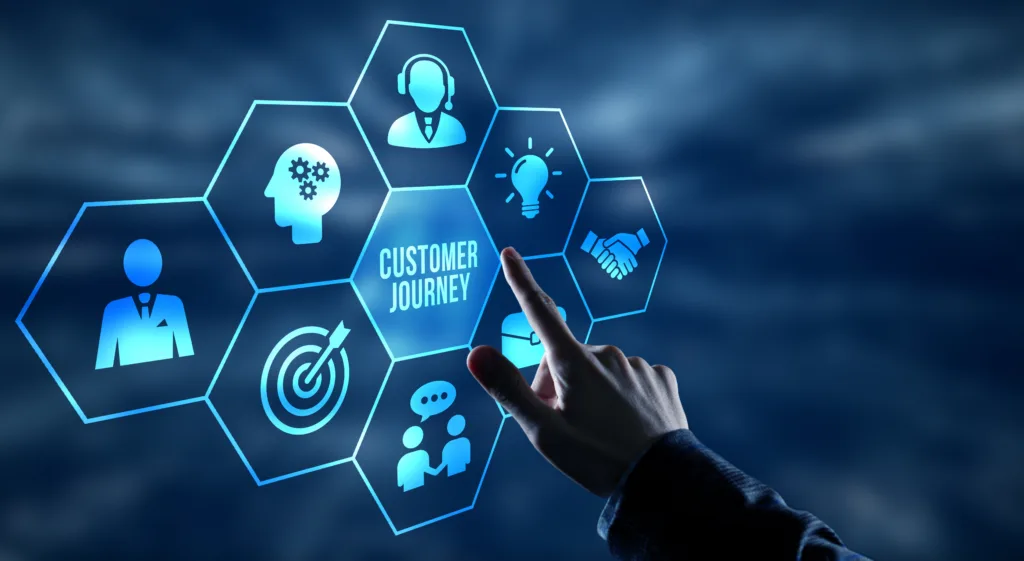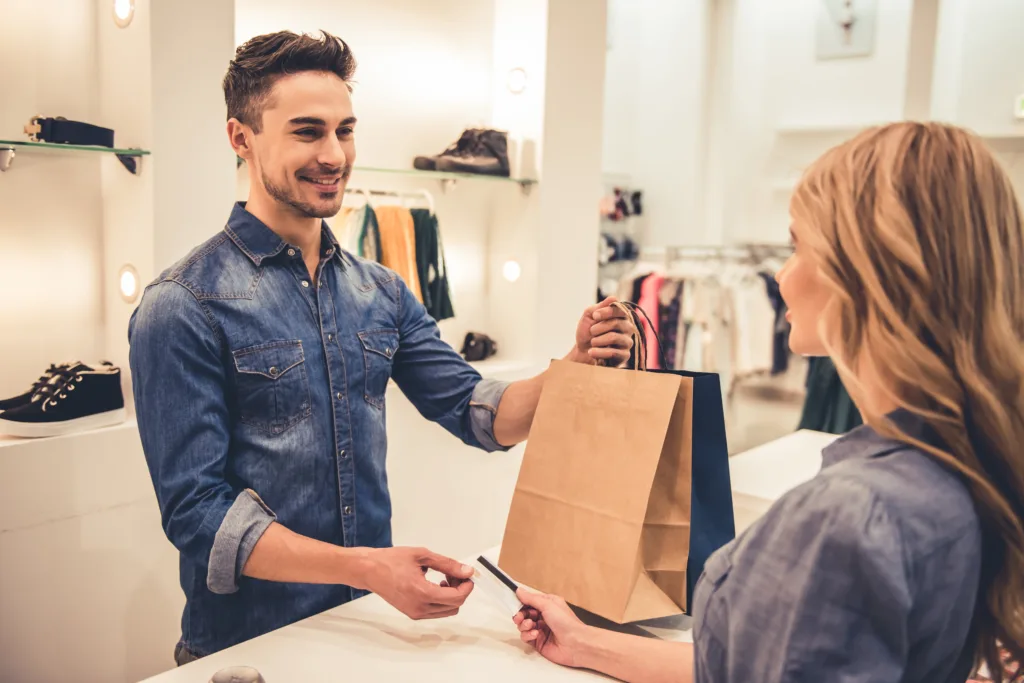Crafting the Customer’s Tale from First Click to Lasting Connection.

Walt Disney’s timeless advice, “Whatever you do, do it well,” resonates profoundly in the context of today’s eCommerce landscape, where the customer journey holds paramount importance. The pre-pandemic era witnessed a relatively linear progression: Awareness, Consideration, Acquisition, Service, and Loyalty. This journey unfolded through touchpoints, albeit increasingly sophisticated, within a predictable pattern of customer engagement.
However, the seismic shifts triggered by the global pandemic have irrevocably transformed the eCommerce landscape. With global eCommerce sales projected to reach a staggering $6.3 trillion by 2024 (a 9.4% growth rate), the post-pandemic customer journey has morphed into a complex, multi-layered odyssey marked by heightened expectations for personalized, engaging, and seamless experiences across digital channels.

The Evolution of Touchpoints in the Customer Journey
Awareness and Engagement: The Digital Front Door
Gone are the days of solely relying on traditional advertising for initial discovery. Platforms like augmented reality (AR) and virtual reality (VR) have emerged as powerful tools for crafting compelling brand narratives that captivate potential customers. IKEA’s AR app, allowing users to visualize furniture in their homes, exemplifies how brands can leverage immersive experiences to enhance awareness and engagement in a digitally dominated environment (Source: IKEA AR App).
Beyond IKEA, furniture giant Wayfair also deploys cutting-edge 3D visualization technology, enabling customers to see products “in-room” using their smartphones or tablets. This immersive experience not only enhances engagement but also increases conversion rates by addressing customers’ concerns about product fit and scale (Source: Wayfair 3D Visualization).
Consideration: Personalization at Scale
Today’s discerning consumers expect brands to understand their unique preferences and tailor experiences accordingly. Advanced analytics and AI-driven solutions empower businesses to analyze vast datasets, offering personalized recommendations and content that resonate on an individual level. Netflix’s recommendation algorithm, curating viewing suggestions based on user behavior, serves as a prime example of the transformative power of personalized engagement in guiding the consideration phase (Source: Netflix Recommendation Algorithm).
Going beyond basic recommendations, Spotify personalizes the entire user journey. From curated playlists based on mood and activity to personalized podcast recommendations, Spotify leverages user data to create a highly engaging and individualized experience, driving long-term loyalty (Source: Spotify Personalized Features).
Acquisition: Frictionless Commerce
The surge in online shopping has underscored the need for seamless purchase experiences. Streamlined checkout processes, diverse payment options, and robust cybersecurity measures are now prerequisites for converting interest into sales. Amazon’s one-click purchasing feature represents the epitome of frictionless commerce, minimizing barriers to acquisition and setting a benchmark for eCommerce efficiency (Source: Amazon One-Click Purchase).
However, frictionless commerce goes beyond just streamlined checkouts. Companies like Apple Pay and Google Pay offer secure and convenient one-click payment solutions, allowing users to complete purchases effortlessly across various platforms. This seamless integration promotes impulsive buying and fosters brand loyalty (Source: Apple Pay, Google Pay).
Service and Loyalty: Beyond the Transaction
Post-purchase engagement has transcended mere transactions, with brands focusing on building enduring relationships. Loyalty programs, proactive customer service, and engaging content strategies play pivotal roles in fostering long-term loyalty. Sephora’s Beauty Insider program, offering personalized rewards and exclusive experiences, demonstrates how brands can cultivate loyalty by enriching the customer’s post-purchase journey (Source: Sephora Beauty Insider Program).
Taking engagement beyond loyalty programs, Nike fosters a vibrant community through its Nike Run Club app, offering personalized coaching plans, guided runs, and social challenges. This community-driven approach fosters brand loyalty and increases customer lifetime value (Source: Nike Run Club).
Beyond the Core Touchpoints: Emerging Trends
While the core stages of the customer journey remain paramount, emerging trends further emphasize the need for agility and innovation:
- Voice Commerce: The rise of voice assistants like Amazon Alexa and Google Assistant is paving the way for voice-activated shopping, adding another layer to the customer journey. Brands must optimize their content and product listings for voice search to remain competitive (Source: Voice Commerce Market Report).
- Social Commerce: Platforms like Instagram and TikTok are increasingly becoming hotspots for product discovery and purchase. Integrating social commerce strategies into the customer journey is crucial for reaching younger demographics and leveraging influencer marketing effectively (Source: Social Commerce Trends).
- Sustainability: Consumers are increasingly prioritizing eco-friendly brands and products. Integrating sustainability practices and transparent communication into the customer journey can attract brand-loyal customers (Source: Sustainability in eCommerce).

Implementing Customer Journey 2.0: Strategies and Examples
To navigate this dynamic landscape, businesses must adopt innovative strategies that reflect the evolved customer journey:
- Leverage Emerging Technologies:
- AR/VR: Beyond beauty and furniture, consider how AR Consider How AR/VR Can Enhance Your Industry
Remember, the effectiveness of AR/VR depends on your specific industry and target audience. Here are some additional examples across different sectors:
- Fashion: Clothing retailers like Asos and Levi’s allow customers to virtually try on clothes using AR apps, reducing returns and boosting conversion rates (Source: Asos AR Try-On, Levi’s Virtual Tailor).
- Automotive: Brands like Volvo and BMW offer VR experiences that allow potential buyers to explore car interiors and exteriors in detail, creating a more immersive and engaging pre-purchase experience (Source: Volvo VR Experience, BMW VR Showroom).
- Travel: Airlines like KLM and Emirates utilize VR tours to showcase destinations and in-flight amenities, helping travelers visualize their vacation and make informed booking decisions (Source: KLM VR Destinations, Emirates VR Experience).
- Education: Museums and educational institutions are increasingly adopting VR to bring history and learning to life, creating interactive and unforgettable experiences for students (Source: British Museum VR Experiences, National Geographic VR Expeditions).
- Enhance Personalization:
- Hyper-Personalization: Move beyond basic demographics and leverage purchase history, browsing behavior, and real-time interactions to craft highly individualized experiences. Sephora’s Beauty Insider program evolves with customer preferences, offering relevant product recommendations and personalized birthday gifts (Source: Sephora Beauty Insider Program).
- Omnichannel Personalization: Ensure a seamless transition between online and offline touchpoints. Sephora utilizes in-store beauty advisors who leverage customer data to personalize product recommendations and offer tailored advice (Source: Sephora In-Store Personalization).
- Prioritize Privacy and Security:
- Transparent Data Practices: Clearly communicate how you collect, use, and protect customer data. Building trust is crucial for fostering long-term loyalty in today’s privacy-conscious environment (Source: CCPA, GDPR).
- Robust Cybersecurity Measures: Implement industry-standard security protocols to safeguard customer data and prevent cyberattacks. Investing in cybersecurity demonstrates your commitment to protecting customer information (Source: NIST Cybersecurity Framework).
- Foster Community and Engagement:
- User-Generated Content: Encourage customer participation through online communities, influencer collaborations, and user-generated content campaigns. This fosters brand advocacy and builds an engaged customer base (Source: User-Generated Content Statistics).
- Interactive Content: Go beyond static product descriptions and create engaging content formats like interactive quizzes, product tutorials, and augmented reality experiences. This increases dwell time and brand recall (Source: Interactive Content Marketing Examples).
- Embrace Continuous Improvement:
- Data-Driven Decisions: Track key metrics throughout the customer journey to identify areas for improvement and personalize further based on data insights. A/B testing different tactics helps identify the most effective strategies (Source: A/B Testing in eCommerce).
- Customer Feedback: Actively solicit customer feedback through surveys, reviews, and social media interactions. Understanding customer pain points and preferences helps refine your approach and address evolving needs (Source: Customer Feedback Management Strategies).

Conclusion
The post-pandemic customer journey demands a reimagined approach to eCommerce and marketing strategies. By embracing technological innovations, enhancing personalization, streamlining purchase processes, fostering deep post-purchase engagement, and prioritizing privacy and security, businesses can create a customer journey that not only meets but exceeds the evolved expectations of today’s consumers. This strategic focus on Customer Journey 2.0 positions companies to delight customers, fostering loyalty and driving growth in the dynamic new eCommerce ecosystem.
If you have questions or need assistance executing these strategies, our team is available at hello@tidalcommerce.ca.
Footnotes:
- Ecommerce Growth Worldwide Will Pick Up Before Tapering Off,” Insider Intelligence (August 23, 2023), (accessed February 14, 2024)
- IKEA, “IKEA Launches IKEA Place, a New App That Allows People to Virtually Place Furniture in Their Home,” (September 12, 2017), (accessed February 14, 2024).
- Wayfair, “Wayfair Unveils New Mobile App Features, Makes Shopping for Home from Anywhere Easier Than Ever Before,” (November 13, 2019), (accessed February 14, 2024).
- Netflix Research, “Research Area: Recommendations,” (accessed February 14, 2024).
- Sephora, “Beauty Loyalty Program,” (accessed February 14, 2024).
- Nike, “Nike Run Club App,” (accessed February 14, 2024).
- ASOS, “ASOS trials ‘See My Fit’ Augmented Reality tool,” (January 14, 2019), (accessed February 14, 2024).
- Levi’s, “The Levi’s® Tailor Shop,” (accessed February 14, 2024).
- Volvo Cars, “Volvo Cars and Varjo Launch World-First Mixed Reality Application for Car Development,” (May 29, 2019), (accessed February 14, 2024).
- BMW, “Virtual and Augmented Reality,” (accessed February 14, 2024).
- KLM, “Take a peek inside the entire KLM fleet – without a ticket,” (November 27, 2019), (accessed February 14, 2024).
- Emirates, “The Emirates VR Experience,” (accessed February 14, 2024).
- National Geographic, “Tech with a Purpose: National Geographic Museum Introduces First Virtual Reality Theater Experience in Washington, D.C.,” (October 3, 2018), (accessed February 14, 2024).
- NIST, “Cybersecurity Framework,” (accessed February 14, 2024).
- Monique Solomons, “90 UGC Statistics: Best Practices, Benefits, and Future Growth,” Linearity (September 12, 2023), (accessed February 14, 2024).
- Ceros, “Create interactive digital content with Ceros,” (accessed February 14, 2024).
- FasterCapital, “Customer Feedback: The Impact of Customer Feedback on Effective Engagement Strategies,” (accessed February 14, 2024).


